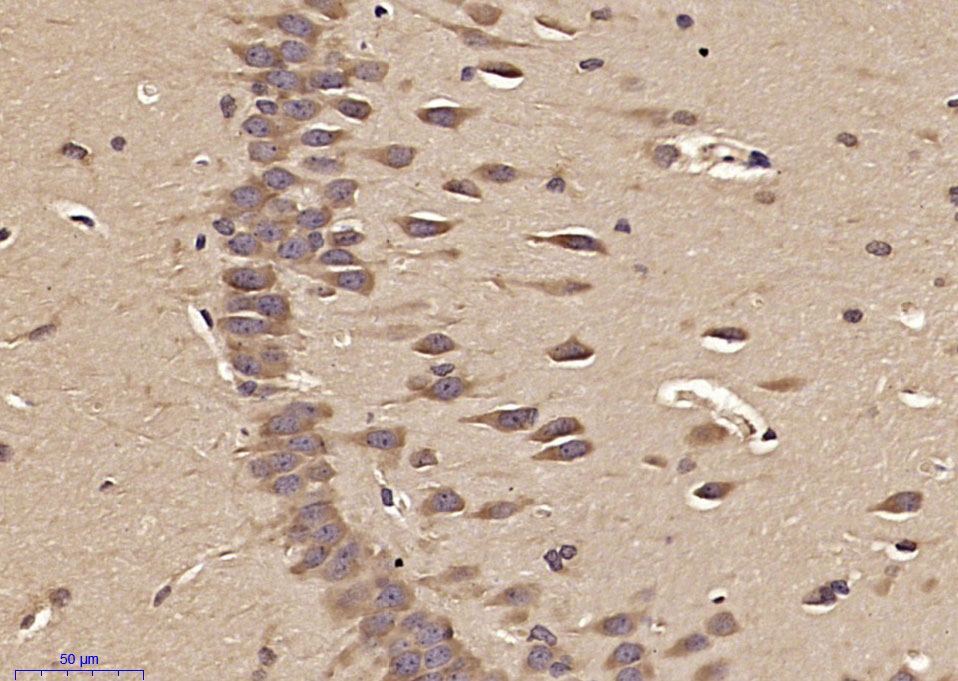Munc13 Rabbit pAb
Munc13 Rabbit pAb
- 产品详情
- 实验流程
- 背景知识
Application
| IHC-P, IHC-F, IF |
|---|---|
| Primary Accession | Q2TAK8 |
| Reactivity | Mouse, Rat |
| Predicted | Human, Chicken, Dog, Pig, Sheep |
| Host | Rabbit |
| Clonality | Polyclonal |
| Calculated MW | 78636 Da |
| Physical State | Liquid |
| Immunogen | KLH conjugated synthetic peptide derived from human Munc13 |
| Epitope Specificity | 1511-1610/1703 |
| Isotype | IgG |
| Purity | affinity purified by Protein A |
| Buffer | 0.01M TBS (pH7.4) with 1% BSA, 0.02% Proclin300 and 50% Glycerol. |
| SUBCELLULAR LOCATION | Cytoplasm. Cell membrane; Peripheral membrane protein. Cell junction; synapse, presynaptic cell membrane. Note: Localized to the active zone of presynaptic density. Translocated to the plasma membrane as response to phorbol ester binding |
| SIMILARITY | Belongs to the unc-13 family. Contains 3 C2 domains. Contains 1 MHD1 (MUNC13 homology domain 1) domain. Contains 1 MHD2 (MUNC13 homology domain 2) domain.Contains 1 phorbol-ester/DAG-type zinc finger. |
| SUBUNIT | nteracts with the N-termini of STX1A and/or STX1B1 and DOC2A. Interacts with BSN. Interacts with RIMS1 which recruits UNC13A to the active zone. Forms homodimers via its first C2 domain. Also interacts via this domain with the zinc finger domain of RIMS2. Part of a complex consisting of ERC2, RIMS1 and UNC13A. Also part of a complex consisting of UNC13A, RIMS2 and RAB3A (By similarity). |
| Post-translational modifications | Phosphorylated upon DNA damage, probably by ATM or ATR. |
| Important Note | This product as supplied is intended for research use only, not for use in human, therapeutic or diagnostic applications. |
| Background Descriptions | Munc 13s are homologues of the C. elegans unc-13 gene product. Three brain specific isoforms are expressed in rat: Munc 13-1, -13-2, and -13-3. Munc 13-1 is a peripheral membrane protein that is enriched in synaptosomes and localized to plasma membranes but absent from synaptic vesicles. It has multiple regulatory domains (C1 and C2 domains) that may mediate diacylglycerol, phospholipid, and calcium binding. The C terminus of Munc 13-1 interacts directly with a putative coiled coil domain in the N-terminal part of syntaxin. It has been shown that Munc 13 is involved in priming synaptic vesicles. These activated vesicles can be released immediately on Ca2+ influx. |
| Gene ID | 84939 |
|---|---|
| Other Names | PWWP domain-containing DNA repair factor 3A, PWWP3A, Mutated melanoma-associated antigen 1, MUM-1, PWWP domain-containing protein MUM1, Protein expandere, PWWP3A (HGNC:29641) |
| Target/Specificity | Expressed in pancreatic islet cells. |
| Dilution | IHC-P=1:100-500,IHC-F=1:100-500,IF=1:100-500 |
| Storage | Store at -20 °C for one year. Avoid repeated freeze/thaw cycles. When reconstituted in sterile pH 7.4 0.01M PBS or diluent of antibody the antibody is stable for at least two weeks at 2-4 °C. |
| Name | PWWP3A (HGNC:29641) |
|---|---|
| Function | Involved in the DNA damage response pathway by contributing to the maintenance of chromatin architecture. Recruited to the vicinity of DNA breaks by TP53BP1 and plays an accessory role to facilitate damage-induced chromatin changes and promoting chromatin relaxation. Required for efficient DNA repair and cell survival following DNA damage. |
| Cellular Location | Nucleus. Note=Recruited to DNA damage sites via its interaction with the BRCT domain of TP53BP1 |
For Research Use Only. Not For Use In Diagnostic Procedures.
Provided below are standard protocols that you may find useful for product applications.
BACKGROUND
Munc 13s are homologues of the C. elegans unc-13 gene product. Three brain specific isoforms are expressed in rat: Munc 13-1, -13-2, and -13-3. Munc 13-1 is a peripheral membrane protein that is enriched in synaptosomes and localized to plasma membranes but absent from synaptic vesicles. It has multiple regulatory domains (C1 and C2 domains) that may mediate diacylglycerol, phospholipid, and calcium binding. The C terminus of Munc 13-1 interacts directly with a putative coiled coil domain in the N-terminal part of syntaxin. It has been shown that Munc 13 is involved in priming synaptic vesicles. These activated vesicles can be released immediately on Ca2+ influx.
终于等到您。ABCEPTA(百远生物)抗体产品。
点击下方“我要评价 ”按钮提交您的反馈信息,您的反馈和评价是我们最宝贵的财富之一,
我们将在1-3个工作日内处理您的反馈信息。
如有疑问,联系:0512-88856768 tech-china@abcepta.com.























 癌症的基本特征包括细胞增殖、血管生成、迁移、凋亡逃避机制和细胞永生等。找到癌症发生过程中这些通路的关键标记物和对应的抗体用于检测至关重要。
癌症的基本特征包括细胞增殖、血管生成、迁移、凋亡逃避机制和细胞永生等。找到癌症发生过程中这些通路的关键标记物和对应的抗体用于检测至关重要。 为您推荐一个泛素化位点预测神器——泛素化分析工具,可以为您的蛋白的泛素化位点作出预测和评分。
为您推荐一个泛素化位点预测神器——泛素化分析工具,可以为您的蛋白的泛素化位点作出预测和评分。 细胞自噬受体图形绘图工具为你的蛋白的细胞受体结合位点作出预测和评分,识别结合到自噬通路中的蛋白是非常重要的,便于让我们理解自噬在正常生理、病理过程中的作用,如发育、细胞分化、神经退化性疾病、压力条件下、感染和癌症。
细胞自噬受体图形绘图工具为你的蛋白的细胞受体结合位点作出预测和评分,识别结合到自噬通路中的蛋白是非常重要的,便于让我们理解自噬在正常生理、病理过程中的作用,如发育、细胞分化、神经退化性疾病、压力条件下、感染和癌症。






